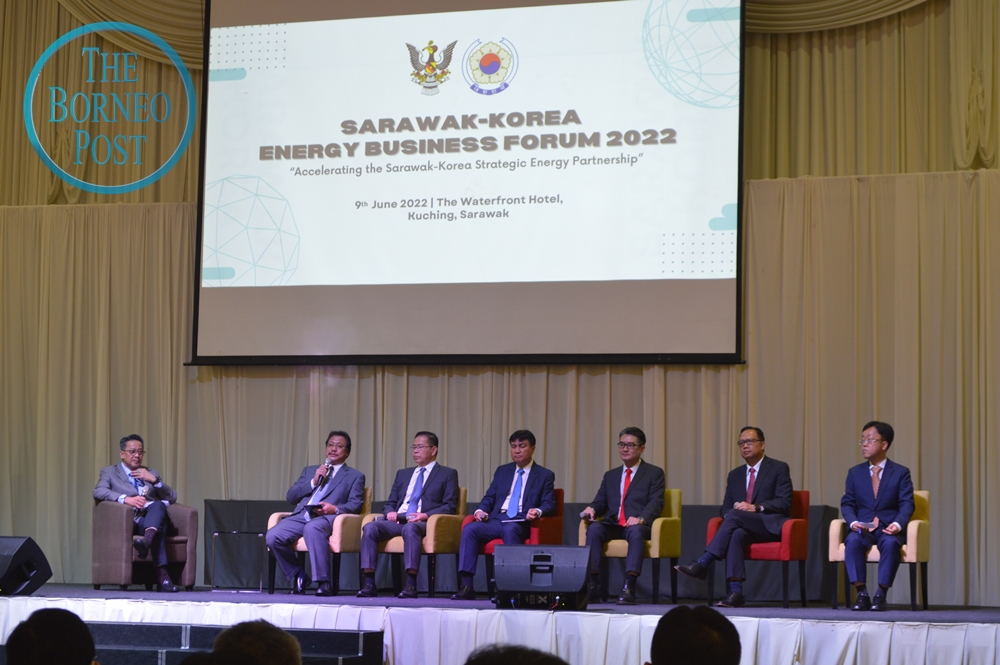
(From left) Sarawak Economic Development Corporation general manager Abdul Hadi Datuk Abdul Kadir, Deputy Minister for Energy and Environmental Sustainability Dr Hazland Abang Hipni, Economic Planning Unit Sarawak director Datu Dr Muhammad Abdullah Zaidel, Sharbini, Hardin, Petroleum Sarawak Bhd Corporate Strategy senior vice president Abang Arabi Abang Narudin, and Korea Energy Economics Institute (KEEI) director of Research Planning and Coordination Dr Lee Ho-Mu during the Sarawak-Korea Energy Business Forum 2022 panel discussion today. – Photo by Chimon Upon
KUCHING (June 9): Sarawak’s natural resources and growing renewable energy sector provides ample opportunities to meet the current growing global demand for green energy.
This was highlighted by panel speakers at the Sarawak-Korea Energy Business Forum 2022 held recently with the theme: ‘Accelerating the Sarawak-Korea Strategic Energy Partnership’.
“Geographically, we are blessed with the resources especially our hydropower and natural resources that makes green hydrogen electrolysis possible and with international shipping routes that intersect our waters.
“Politically, we are stable and we can count on the right support that would ensure steady growth and development of our Hydrogen Economy.
“Investors can rest assure and be confident when investing in Sarawak,” SEDC Energy Sdn Bhd chief executive officer Robert Hardin highlighted.
“Over the past year, green hydrogen has been the talk especially in the energy industry, touted as the future fuel which being adopted, would be able to bring down carbon emissions level that is safer for our environment, and would allow for a more sustainable, greener future for the generations to come.
“Sarawak’s Hydrogen Economy hinges on our capability to produce hydrogen, sustainable green hydrogen as opposed to the grey hydrogen which is what is widely available today.
“This can only happen with the Sarawak government’s forward thinking in capitalising our renewable energy sources that Sarawak has.
“Hydropower is the most stable form of renewable energy and available 24 hours if compared to solar and wind power. In this region, we have the most established hydropower value chain,” he added.
Sarawak’s location, being in the path of a busiest international shipping routes, also makes us one of the most ideal location for export either to Europe and Asia.
“The global demand for green hydrogen is consistently rising, and we can start to see this with other countries committing for large scale green hydrogen projects.
“This spur in demand which is due to increase by 2030 to 2050 as more countries are committing to net-zero carbon emissions goals.
“This sparked interest and demand for the upcoming future allows us to plan and position Sarawak as an exporter of green hydrogen,” Hardin said.
Aside from that, he pointed out that Sarawak has made it clear on its commitment to the environment, with the recent call of amendments to Sarawak’s Land Code Bill.
“With these changes, Sarawak will be able to ensure that any means of decarbonising industries or rather the value of carbon capture, utilisation and storage (CCUS) can and will be in our favour.
“With this amendment and the planning to regulate and develop our carbon credit markets, we can see yet another commodity that is tradeable, hopefully to the global markets.”
Meanwhile, Sarawak Energy Bhd (Sarawak Energy) highlighted that it is committed reducing its carbon emission by increasing its renewable energy sources.
“We are very much aligned with the UN SDG-7, to provide affordable and clean energy for all balancing energy security, sustainability, and affordability in supporting the growth of Sarawak.
“Leveraging on hydropower development, complemented by indigenous thermal resources for energy security and diversity, we have achieved a 71 per cent reduction in carbon emission intensity from 2011 to 2020 and we offer among the most competitive tariffs in the region,” said Sarawak Energy Group chief executive officer Datu Sharbini Suhaili.
In 2021, Sarawak Energy also signed the symposium declaration on the principle that the only acceptable hydropower is is sustainable hydropower.
Sarawak Energy pointed out that its gen-mix has transitioned from being over 90 per cent fossil fuel in 2010 to predominantly renewable energy, renewable hydropower within a span of less than 10 years.
Sarawak Energy is also aiming to adding solar energy to its gen-mix by 2030 and is now developing its first floating solar farm which is expected to be in 2023.
With these expected increase in renewable energy resources, Sarawak Energy hopes that this would attract opened up the opportunities for us to develop more energy/electric transmission interconnections with our neighbors
“Sarawak can indeed be the battery of Asean interconnections from Borneo to elsewhere in the region.
“These various projects within Borneo form an important part of the broader Asean power grid,” Sharbini added.
